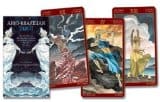
Afro-Brazilian Tarot
, by Alice Santana and Guiseppe Palumbo
Kit: Llewellyn Worldwide, 0738709603, 78 cards plus instruction booklet, 2006
I’m not sure what I expected when I requested this deck for review (although I was sure that the artwork would be impressive, based on other decks from Lo Scarabeo). Oh, I’m familiar with both the Tarot and with Candomble (the Afro-Brazilian equivalent of the Afro-Cuban Santeria), and I do understand the desire to provide divination decks which go outside the commonly accepted parameters which are associated with the Tarot.
The deck, which is a standard deck as far as number of cards and divisions, is accompanied by a multilingual instruction booklet (English, Italian, Spanish, French, and German, I believe) which gives very basic meanings for each of the cards, as well as an extremely simplified layout (in keeping with the traditional divination method of the Yoruban people, which the Tarot is definitely not).
Although the suits carry the traditional names – chalices, pentacles, wands and swords – some of the images are slightly unconventional. The chalice suit is represented by soperas, which are traditionally used as containers of the physical representation of the orixas; the pentacles are represented by opon, the plates used in traditional divination by cowry shells and the shells themselves; while the wands and swords are more conventional.
The twenty-two major arcana cards represent seventeen orixas and five other basic concepts. The images on the cards are, in keeping with the energies associated with the orixas, quite strong and primitive. The orixas are not, generally, represented with an anthropomorphic or zoomorphic form. They are represented by their symbols – a sword for Ogun (orixa of war and iron), stones for Xango, fresh water for Oxum (orixa of rivers), salt water for Yemanja (orixa of salt water and the oceans), and so on. Of course, over the centuries, certain “god-forms” have come to be associated with the orixas. These images inform and affect our perceptions of the orixas.
The syncretism which resulted from the official banning of the Yoruban belief system and the enforced adherence to Roman Catholicism led to a much richer religious experience for the followers of Candomble. Although some people are disconcerted by the similarities between Candomble and Vodun, they simply represent two separate developments from the same roots (such as differences/similarities between Roman Catholicism and Pentecostal Christianity). Neither is better or worse, they are simply different.
One thing which those used to more conventional Tarot decks may find a bit unusual is that, generally, the faces of the court cards (in the minor arcana) are obscured. This is in keeping with Yoruban tradition. The background imagery is drawn from Brazilian motifs with brightly coloured birds and primal forest scenes among others.
The recommended layout pattern for these cards is based on the system of cowry shell divination and varies significantly from more common layouts. It uses two parallel rows of four cards each, representing the past, the present, the potential future, the advice, the state of mind, the energies, the obstacles, and the final response.
The instruction books also contains a short list of quick response meanings (draw one card and get a yes, no, or maybe response to your question) – six yes responses, three no response, and thirteen varying shades of maybe. These responses do not depend on the cards being upright or reversed. In fact, there are no reversed meanings for any of the cards in any circumstance, which I personally like on several levels.
Doing a few layouts, I found the cards to be easy to understand and quite clear in their indications. I was very impressed with the quality of the cards themselves, and by the images they contain, as well as the imagery they conjure up within my own mind.
Although I am trained in Santeria (at a very basic level) rather than Candomble, and acknowledging that differences do exist between the two systems, I found the deck an exceptionally beneficial way to explore some of the more uncommon aspects of situations.







